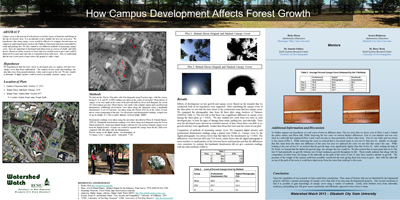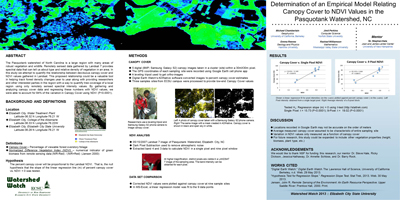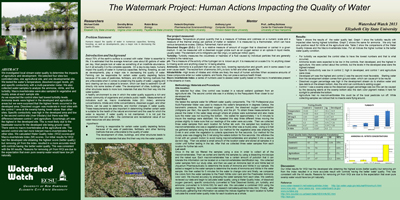| Student Posters |
 |
Analyzing Factors that Influence Loblolly Pine (Pinus taeda) at Elizabeth City State University
Mentor: Barry Rock, UNH |
| Kalyx McDonald (MVSU), Courtney Farmer (ECSU), Jazette Johnson (SC), Malcolm McConner (ECSU), Alicia Reynolds (ECSU) |
 ABSTRACT ABSTRACT
Trees are very important to the environment as they provide oxygen to living organisms, uptake carbon dioxide, improve air quality by absorbing potentially harmful pollutants (e.g., carbon monoxide, sulfur dioxide), produce carbohydrates (sugars ,cellulose, starch, etc.) and serve as an climate indicator (e.g., precipitation). In the Southern United States, loblolly pine trees (Pinus taeda) are the most essential and widely produced trees. It is extensively used for lumber and pulpwood. We extracted tree cores from the loblolly pines across the campus of Elizabeth City State University and compared the correlation of diameter at base height (DBH) and tree age. Once we collected the cores, we calculated the estimated age and determined the overall health condition of the trees, by analyzing the growth rings in each core. We also determined what variables contribute to the positive or negative growth of a tree (e.g., mulch, vines). (JPEG) (PowerPoint)
|
 |
How Campus Development Affects Forest Growth
Mentor: Annette Schloss, UNH |
| Ricky Dixon (MVSU), Jessica Hathaway (ECSU) |
 ABSTRACT ABSTRACT
Canopy cover is the percent of a fixed area covered by layers of branches and foliage at the top of a forest's trees. It is an indicator to how healthy the trees are in an area. We hypothesize that using canopy cover would be effective to compare forested areas on campus in undeveloped areas (such as the Outdoor Classroom) and areas surrounded by roads and parking lots. We also wanted to test different methods of measuring canopy cover. Trees are important in developed and urban areas as sources of shade, and other factors. Based on earlier research we knew that trees needed room to grow and could be deprived of oxygen and water due to competition from other trees. Also we understand that the tree’s roots need a source above the ground to collect water. (JPEG) (PowerPoint)
|
 |
Determination of an Empirical Model Relating Canopy Cover to NDVI Values in the Pasquotank Watershed, NC
Mentor: Stephen Hale, UNH |
| Michael Chamberlain (UCB), Jimil Perkins (NSU), Emma Reeves (HU), Rashad Williamson (MVSU) |
 ABSTRACT ABSTRACT
The Pasquotank watershed of North Carolina is a large region with many areas of robust vegetation and wildlife. Remotely sensed data gathered by Landsat 7 provides spectral data that can tell us about type and relative density of vegetation in an area. In this study we attempt to quantify the relationship between deciduous canopy cover and NDVI values gathered in Landsat. This proposed relationship could be a valuable tool in helping track forest density changes year to year along with providing researchers and other interested parties in the region with a way to quantify tree coverage of a local region using only remotely sensed spectral intensity values. By gathering and analyzing canopy cover data and regressing these numbers with NDVI values, we were able to account for 84% of the variation in Canopy Cover using NDVI (P<0.0001). (JPEG) (PowerPoint)
|
 |
The Watermark Project: Human Actions Impacting the Quality of Water
Mentor: Jeff Schloss, UNH |
| Michael Cobb (ECSU), Kelechi Onyiriuka (ECSU), Robin Brice (FSU), Anthony Lynn (WSSU), Dorothy Brice (VUU) |
 ABSTRACT ABSTRACT
We investigated local stream water quality to determine the impacts of agriculture and development. We selected four sites two controlled sites, one agricultural site, and one developmental site. We tested the water’s temperature, dissolved oxygen levels, pH, and specific conductivity with a multi-parameter meter. We also collected water samples to analyze the ammonia, nitrite, and the turbidity. Macro invertebrates were also sampled in vegetative and muddy areas at each sample site.
As we expected the control sites had lowest turbidity levels. Ammonia levels were highest in the developed and agricultural areas but we were surprised that the highest levels occurred in the developed area. Dissolved oxygen was moderate in most sites with the control 1 area at the swamp having lower values than other sites. Specific conductivity was high in the developed area and low in the second control site (river tributary) but there was little difference between control 1 and agriculture. Surprisingly pH was the highest in the developed site. This is most likely due to the headwater source for the developed site being ground water.
There were no macro invertebrates at the agricultural site. The second control site had more tolerant macro-invertebrates than other sites. We calculated Water Quality Index (WQI) scores and Macro-invertebrate Index (MI) scores. Our initial results for WQI had the developed site obtaining the highest score (better quality) but removing pH from the index resulted in a more accurate result with controls having the better water quality. This was consistent with the MI results. Reasons for removing pH from WQI are due to the expectation that even pure swamp water would have low pH naturally. (JPEG) (PowerPoint) |
 |
|
| |
|